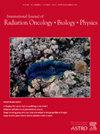A Longitudinal Study to Correlate Neurocognitive Changes of IDH-Mutant and IDH-Wildtype Glioma Patients after Chemoradiotherapy with Changes on Resting-State MRI
IF 6.4
1区 医学
Q1 ONCOLOGY
International Journal of Radiation Oncology Biology Physics
Pub Date : 2024-10-01
DOI:10.1016/j.ijrobp.2024.07.059
引用次数: 0
Abstract
Purpose/Objective(s)
This prospective observational study investigates mechanisms behind neurocognitive function (NCF) decline after partial-brain irradiation in malignant glioma patients. We aim to use resting-state functional MRI (RS-fMRI) to identify the dominant network-level disturbances post-radiation therapy (RT) that correlate with NCF changes.
Materials/Methods
Adult patients with IDH-wildtype or IDH-mutant gliomas underwent NCF test using the NIH Toolbox Cognitive Function Battery at baseline and 6 months post RT. The battery includes fluid cognition tests: dimension change card sort test (executive function), flanker test (attention), picture sequence test (episodic memory), list sorting test (working memory), and pattern comparison test (processing speed). The five test scores were then combined into an age-normalized composite score, from which the percent change of composite (PCC) was calculated relative to the baseline. To determine a potential correlation between NCF and changes in brain functional connectivity (FC), we used seed-based FC analysis from a 12-minute RS-fMRI scan. A split-sample approach was used for analysis, with a 26-patient training set and a 6-patient validation set, iterated 200 times. Within each run, connectivity-regression analysis within the training set was first used to identify which intra- or inter-network FC change was most significantly associated with PCC, and a linear regression was used to predict FC change of the selected networks using the validation set. Permutation test was used to evaluate the significance of network selection, and R2 value was used to evaluate the predictive performance.
Results
From September 2020 to December 2023, there were 43 patients who had baseline data, while 32 patients completed 6-month follow-ups and were evaluable. The mean NCF composite changed from 88.8 (±16.2) at baseline to 91.1 (±19.4) at 6 months. The mean PCC was 2.9 (±13.7), including 12 patients with negative PCC (Decline cohort) and 20 patients with positive PCC (Non-decline cohort). The clinical, treatment, and dosimetric characteristics between two cohorts were not significantly different among 24 variables examined. The mean R2 was 0.36 (±0.27). The most significant correlations with PCC were consistently observed in the inter-network FC changes between Default Mode Network to Medial Temporal Lobe (DMN-MTL, P = 0.005) and Parietal Memory Network to MTL (PMN-MTL, P = 0.02). Sensitivity analyses using only FC maps from the contra-lateral side of the tumor confirmed the same finding.
Conclusion
RS-fMRI changes post RT correlated with NCF decline, suggesting its potential as an imaging biomarker. Specifically, disruption of inter-network FC between DMN-MTL and PMN-MTL may be key mechanism underlying RT-induced NCF decline, warranting further investigation.
将 IDH 突变型和 IDH 野生型胶质瘤患者化疗后的神经认知变化与静息状态磁共振成像变化相关联的纵向研究
本前瞻性观察研究探讨了恶性胶质瘤患者部分脑照射后神经认知功能(NCF)下降的机制。我们的目的是利用静息态功能磁共振成像(RS-fMRI)确定放疗(RT)后与神经认知功能变化相关的主要网络水平干扰。材料/方法患有IDH野生型或IDH突变型胶质瘤的成人患者在基线和RT后6个月时接受了NIH工具箱认知功能测试。该测试包括流体认知测试:维度变化卡片排序测试(执行功能)、侧翼测试(注意力)、图片序列测试(外显记忆)、列表排序测试(工作记忆)和模式比较测试(处理速度)。然后将五项测试的得分合并为一个年龄归一化的综合得分,并从中计算出相对于基线的综合变化百分比(PCC)。为了确定 NCF 与大脑功能连通性(FC)变化之间的潜在相关性,我们使用了基于种子的 FC 分析,该分析来自 12 分钟的 RS-fMRI 扫描。分析采用了分割样本的方法,26 名患者为训练集,6 名患者为验证集,反复进行 200 次。在每次运行中,首先在训练集中进行连接性回归分析,以确定哪些网络内或网络间的 FC 变化与 PCC 的关系最为显著,然后使用线性回归预测验证集中所选网络的 FC 变化。结果2020年9月至2023年12月,有基线数据的患者有43例,完成6个月随访并可评估的患者有32例。平均 NCF 综合指数从基线时的 88.8(±16.2)变为 6 个月时的 91.1(±19.4)。PCC平均值为2.9(±13.7),包括12名PCC阴性患者(下降队列)和20名PCC阳性患者(非下降队列)。在检查的 24 个变量中,两组患者的临床、治疗和剂量学特征无显著差异。平均 R2 为 0.36(±0.27)。在默认模式网络到内侧颞叶(DMN-MTL,P = 0.005)和顶叶记忆网络到MTL(PMN-MTL,P = 0.02)之间的网络间FC变化中,始终可以观察到与PCC最明显的相关性。结论RT后RS-fMRI的变化与NCF的下降相关,表明其具有作为成像生物标志物的潜力。具体来说,DMN-MTL和PMN-MTL之间网络间FC的破坏可能是RT诱导NCF下降的关键机制,值得进一步研究。
本文章由计算机程序翻译,如有差异,请以英文原文为准。
求助全文
约1分钟内获得全文
求助全文
来源期刊
CiteScore
11.00
自引率
7.10%
发文量
2538
审稿时长
6.6 weeks
期刊介绍:
International Journal of Radiation Oncology • Biology • Physics (IJROBP), known in the field as the Red Journal, publishes original laboratory and clinical investigations related to radiation oncology, radiation biology, medical physics, and both education and health policy as it relates to the field.
This journal has a particular interest in original contributions of the following types: prospective clinical trials, outcomes research, and large database interrogation. In addition, it seeks reports of high-impact innovations in single or combined modality treatment, tumor sensitization, normal tissue protection (including both precision avoidance and pharmacologic means), brachytherapy, particle irradiation, and cancer imaging. Technical advances related to dosimetry and conformal radiation treatment planning are of interest, as are basic science studies investigating tumor physiology and the molecular biology underlying cancer and normal tissue radiation response.

 求助内容:
求助内容: 应助结果提醒方式:
应助结果提醒方式:


